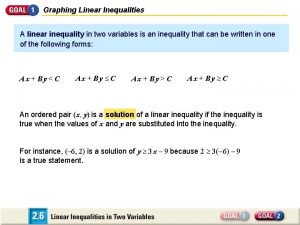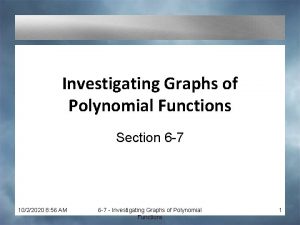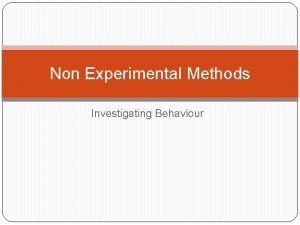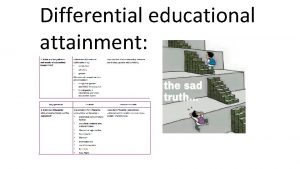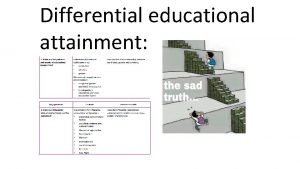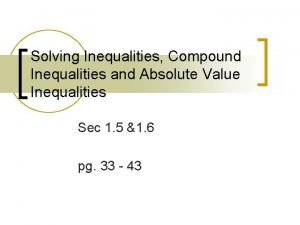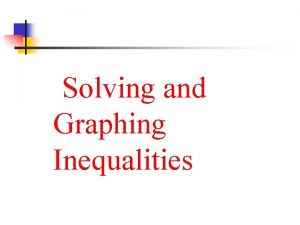Investigating Inequalities in Educational Attainment Michelle Jackson Department



















- Slides: 19

Investigating Inequalities in Educational Attainment Michelle Jackson Department of Sociology Nuffield College, Oxford

Inequalities in educational attainment p Development of educational systems during 20 th Century as response to changing economic and occupational structures p Sociological interest in class, ethnic and sex inequalities in educational attainment p E. g. Class inequalities n Children of salariat (professional and managerial) background are around five times more likely to take A-level courses, rather than taking vocational courses or leaving education than are children of working class background n In England&Wales, seems to be little change in extent of class inequalities over time

Primary and secondary effects p Boudon n Primary effects – those that result from previous academic performance (may be present due to range of factors – e. g. genetic, cultural) n Secondary effects – those that result from educational choices made by children p In this project, examining relative importance of primary and secondary effects in creating inequalities in educational attainment p Following results relate to class inequalities in transition to A-level in England Wales (see reference) p Look at the transition to A level at three points in time n When students are 16 in 1974, 1987, 1996

Data p Use data from National Child Development Study and Youth Cohort Study n 1974: NCDS. Continuing birth cohort study covering all children born in GB in one week in 1958 n 1987 and 1996: YCS. Study commissioned by DEE (now Df. ES). Cohorts of young people in England Wales aged 16 and upwards p Three variables in analyses n Class background. Father’s (or head of household’s) Goldthorpe class. Use 3 class simplification: salariat, intermediate+petty bourgeoisie, working class n Academic performance. Performance in public examinations in mathematics and English. Scores attached to grades summed, inverted, and standardised to be z-scores with mean of 0, s. d. of 1 n Transition to A level p In NCDS, whether student in education after age of 16 p In YCS, question asking whether studying A/AS levels

Descriptive statistics

Distinguishing primary and secondary effects p Run binary logistic regression n Response variable: whether an individual reaches A level education or not n Explanatory variable: standardised performance scores (maths and English scores) p Analyses run separately for each class p Three time points – 1974, 1987, 1996

Graphical representation of regression of transition to A level work on academic performance: 1974

Graphical representation of regression of transition to A level work on academic performance: 1987

Graphical representation of regression of transition to A level work on academic performance: 1996

Primary effects p Differences in performance distributions between three classes p Primary effects clearly operate, with no evidence of general decline

Graphical representation of regression of transition to A level work on academic performance: 1974

Graphical representation of regression of transition to A level work on academic performance: 1987

Graphical representation of regression of transition to A level work on academic performance: 1996

Secondary effects p Over time, curves start sharp upward rise at lower levels of performance p Strong class differences in all three periods p Gaps between curves widest at intermediate levels of performance (around 0). Gaps narrow as move to either extreme of performance range p What is the relative importance of primary and secondary effects?

Integrating p Integral to be evaluated: where μ is the mean of the performance scores and σ the standard deviation and a is the constant and b the performance coefficient from the regression model p By calculating integral, can distinguish two components of any class transition rate n Can calculate transition rates for each class n Can carry out counterfactual analyses by combining performance distribution for one class with transition propensities of another

Results of integrations Counterfactuals p What would happen if we allowed intermediate and working class children to maintain their own performance distribution, but to have the same transition propensities as salariat children?

Odds ratios

Conclusions and future work p Both primary and secondary effects are important. If we eliminated secondary effects, there would be substantial impact on class differentials p Will examine later educational transition – school to university p Method can be used to look at other inequalities. Will also examine ethnic and sex inequalities in educational attainment

Conclusions and future work p Datasets: NCDS, BCS, YCS p Comparative analyses with colleagues from Sweden, France, Germany, the Netherlands p Policy implications n Policy which could eliminate primary effects would clearly have great impact n However, effects of pre-school intervention likely to wash out later on. Eliminating secondary effects might be a more plausible policy goal p Reference n Jackson, M. , Erikson, R. , Goldthorpe, J. H. and Yaish, M. (forthcoming) ‘Primary and Secondary Effects in Class Differentials in Educational Attainment: the Transition to A-Level Courses in England Wales, Acta Sociologica
 Michelle jackson oxford
Michelle jackson oxford Jackson state university finance department
Jackson state university finance department Investigating the graph of an inequality
Investigating the graph of an inequality What is this shape
What is this shape Investigating science hsc
Investigating science hsc Body stream
Body stream Investigating science sample questions
Investigating science sample questions Investigating the world of work. lesson 1
Investigating the world of work. lesson 1 Specific heat capacity question
Specific heat capacity question Investigating skills thomas edison
Investigating skills thomas edison Investigating digital graphics
Investigating digital graphics Investigating and making a case for drug diversion
Investigating and making a case for drug diversion Investigating graphs of functions for their properties
Investigating graphs of functions for their properties Investigating graphs of polynomial functions
Investigating graphs of polynomial functions Cell theory contributors
Cell theory contributors Investigating graphs of polynomial functions
Investigating graphs of polynomial functions Methods of investigating behaviour
Methods of investigating behaviour Investigating polynomials
Investigating polynomials Language
Language Investigating graphs of functions for their properties
Investigating graphs of functions for their properties


